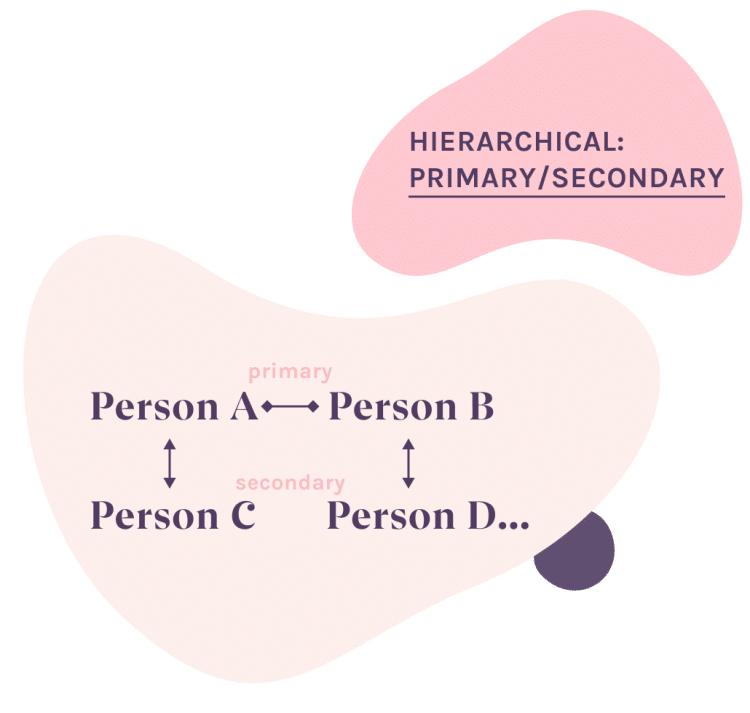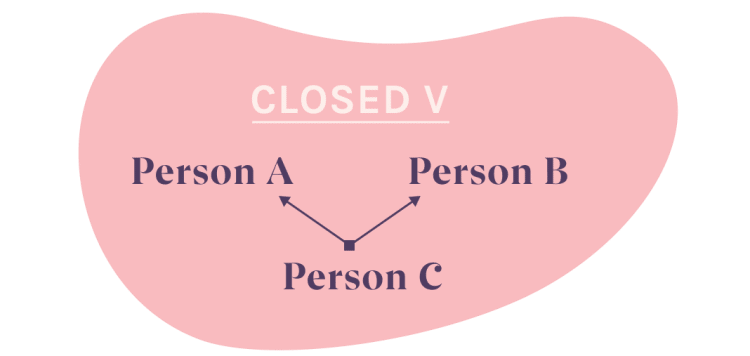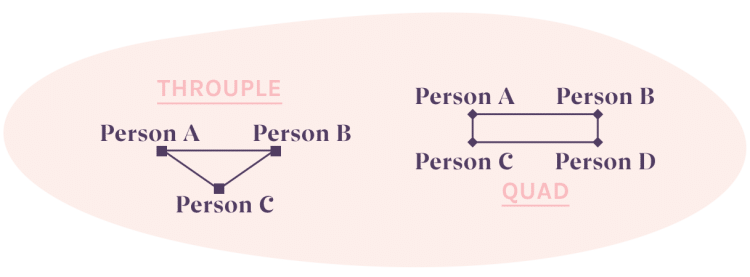

What Is Ethical Non-Monogamy?
Intro to ENM Relationships
Your complete guide to ENM Relationships What Is Ethical Non-Monogamy?
Intro to ENM Relationships

Many people enjoy the benefits of non-monogamous relationships (ENM), and although the practice of non-monogamy is increasing in popularity, the stigma around it does not seem to be decreasing. Some people report feeling uncomfortable about this form of relationship, and others may disapprove entirely.
Of course, this discomfort around or misunderstanding of non-monogamy doesn’t apply to everyone, yet, still, there seems to be a discordance between what most people think about non-monogamy and how it actually operates.

The above equation is how most of us regard romantic relationships. Yet, what if this wasn’t the only way? Although the structure of a typical monogamous coupling suits the above design, not all romantic relationships follow a “one size fits all” format. What happens when more people are added to the mix?
If you’re new to the topic but want to learn more, you’ve come to the right place. Keep reading to find out:
- What is ethical non-monogamy?
- How does ethical non-monogamy differ from monogamous relationships?
- What are the different structures involved in ethical non-monogamy?
- Would a non-monogamous relationship work for you?
“A world where it is safe to love is a world where it is safe to live.”― Serena Anderlini-D’Onofrio
Do you already know your attachment style? Find it out with our free attachment style quiz for couples and ENM relationships.

What is Ethical Non-Monogamy (ENM)?
The concept of ethical non-monogamy is quite alien to many people. Yet, hints of ENM are already quite prevalent in Western society – it’s just that most of us don’t view them that way.
Consider dating, for example. Is going on dates with different people non-monogamy? Or is it only considered non-monogamy when we’re involved in serious relationships but still romantically seeing others?
ENM Meaning
Ethical non-monogamy (ENM; sometimes also referred to as consensual non-monogamy) is the practice of being romantically involved with multiple people who are all aware of and agree to this relationship structure.
Monogamy vs. Ethical Non-Monogamy
The fantasy of monogamy is that we all have a “soulmate for life,” – but in reality, it’s really just a commitment to one person at a time.
We all spend a certain number of years in the dating pool, meeting different people until we feel like we’ve found “the one.” Some of us are lucky and meet that special person early in life – but this is usually the exception. Many have to keep testing the waters until they find their partner. Others may never really leave the dating pool at all – even if they find someone that they’re happy to commit to.

Approximately 4-5% of relationships are consensually non-monogamous [1]. Despite the fact that studies have shown that monogamous people invest more effort into maintaining their relationships than non-monogamous [2], this doesn’t mean that one form of relationship is superior to the other. In fact, this finding can be interpreted in a number of ways – one of which may be that monogamous people are afraid of losing their partners because they’re all they have. It could also imply that non-monogamous partners feel more secure with each other.
However, these are just inferences – studies have shown no significant differences in levels of relationship satisfaction between monogamous and non-monogamous relationships. Yet it was reported that monogamous individuals might feel less content with the quality of communication and openness in their relationships in comparison to their non-monogamous counterparts [2]. A possible explanation for this finding may be that people in non-monogamous relationships are more open to discussing their physical and emotional needs than monogamous couples.

Ethical Non-Monogamy vs. Cheating
In an ethical non-monogamous relationship, everyone involved must consent to the relationship structure. Yet, one of the main misconceptions of non-monogamy is that it is essentially an excuse for cheating on a partner. However, at its core, ethical non-monogamy is inherently different from cheating as it places a strong focus on consent, honesty, and openness. Cheating, in contrast, is a betrayal of trust [3].
Types of Ethical Non-Monogamous Relationships
Not all non-monogamous relationships are the same. Some relationship structures imply that everyone is romantically interested in each other, others not so much. Below, we’ll outline some of the more common ethical non-monogamous (ENM) relationship structures:
Polyamory
In polyamory, love is the central concept, and this love is shared in different ways with multiple people instead of just one partner [4].

Technically, we can regard friendships as polyamorous: we allow ourselves deep connections with multiple friends at once. Polyamorous people are similar in that they extend their romantic needs with multiple partners simultaneously. Although polyamory is not associated with one specific sexual identity, it is most popular among bisexuals and heteroflexibles [4].
On an important note – a loving connection is different from a sexual desire or intention. In polyamory, you can have both a loving connection and sexual experiences with multiple partners.

Primary/Secondary
The most common ENM relationship is a form of polyamory: the primary/secondary model [2].
The main difference between monogamous and primary/secondary ENM is that in the latter, both partners can enjoy other partners sexually and/or emotionally. However, the emotional commitment to the sole partner in monogamous relationships and to the primary partner in non-monogamous ones is the same [2].
Although people involved in ENM relationships report being content within the relationship, findings have shown that a particularly strong connection with one primary partner can limit the extent to which people are satisfied with other partners [2]. This finding may support the primary/secondary relationship structure, as it demonstrates the persistent emotional commitment between two individuals despite having multiple partners.

Closed V
The “closed V”, or vee, is the second most common type of ethical non-monogamous relationship [2].
Imagine three people, each on each edge of a letter V. Only the person at the bottom of the V is connected to the two points at the top – the other people. Thus, in a closed V, one person is romantically involved with two others – these two people are not involved with each other.

Throuple/Quad
Unlike the closed V where only one person is romantically involved with two others, a throuple, or quad, is when three people – or four in a quad – are all romantically or sexually involved with one another [5].

Monogamish
Monogamish relationships are neither fully monogamous nor fully non-monogamous [5]. The way it works is that, occasionally, the partners open the relationship up to another person, or multiple people. This is often a way of meeting sexual needs rather than for establishing an emotional connection with others.
This makes securely attached people more likely to feel emotionally secure and satisfied in their intimate relationships. They’re comfortable being in a couple, but also secure enough to be by themselves.
The Stigma of Non-Monogamy
It’s pretty clear that non-monogamous relationships aren’t widely accepted in the most positive light.
In general, ethical non-monogamists are often labeled as more promiscuous, less trustworthy, and more likely to contract STIs than those in monogamous relationships [1].

However, in actuality, patterns of sexually risky behavior have been shown to be more common in unhappy, and thus unfaithful, monogamous relationships [6]. It’s likely that this mislabelling of non-monogamous individuals comes from a lack of understanding of how these relationships function, as clearly, there is no basis for it.
Intriguingly, non-monogamy has been linked to the feminist movement as an act against the heteronormative and monogamous default of relationships [7]. This perception may stem from non-monogamy’s association with polygamy – which is when one man has multiple wives. Polygamy clearly clashes with the feminist perspective – which is that all genders should have the equal right to be in a relationship with whoever (and how many people) they wish to.
How to Practice Ethical Non-Monogamy
As with any type of relationship, ethical non-monogamy is best practiced through open dialogue, trust, and honesty. All of the people involved should fully understand and explicitly consent to being in the relationship that works best for them. Besides establishing boundaries, expectations, and even desires at the beginning of the relationship, practicing ENM is pretty similar to being in any relationship.
How Do I Know if ENM Is Right for Me?
So far, we’ve gone over some of the basics of non-monogamous relationships. But, how can you tell if this type of relationship is right for you? We’ll leave you with a couple of points to consider:

How Do You Handle Jealousy?
Non-monogamy may work for you if you feel like you’re not “the jealous type.”
It’s not that non-monogamous people don’t feel jealousy, but if they are involved in an adaptive non-monogamous relationship, then it’s likely that they process these feelings differently [2].
Of course, jealousy is a common, human emotion – so non-monogamists are perhaps just as likely to experience it as monogamists. Nevertheless, it’s probable that non-monogamists recognize, process, and manifest jealousy in ways that don’t negatively affect their relationships. This is because, from the outset, the relationship was built on the premise of creating multiple physical or emotional connections with other people [8]. In many ways, this open and honest approach to managing expectations may be a constructive way of handling jealousy in all types of relationships – be they non-monogamous or monogamous.
If you’d like to know more about how your attachment style affects how you cope with jealousy, check out our article on Jealousy in Relationships.
How Do You Communicate Your Thoughts and Feelings in a Relationship?
Research has shown that people in ENM relationships experience greater trust, honesty, intimacy, and even friendship toward their partners, as compared to people in other types of relationship [1]. But why might that be? The keyword here is communication.
Communication is a core problematic issue for many relationships. Yet, non-monogamists report a greater level of satisfaction with the communication and openness in their relationships than monogamous individuals [2]. Furthermore, ENM relationships typically value open discussion around sexual desires and experiences as it helps them to process any feelings of insecurity or negativity towards their partners. Therefore, the ability to express your thoughts, feelings, and desires is essential if you’re considering getting involved in a non-monogamous relationship.
If you feel comfortable with this level of openness – or are at least willing to work towards it – an ENM relationship may work for you.

What Is Your Attachment Style?
Perhaps unsurprisingly, ethical non-monogamous relationships share much of the same qualities as secure attachment relationships; the people involved are bases for safety, emotional stability, and support [1]. In fact, most people in ENM relationships have a secure attachment style. After all, if you’re capable of sharing your partner(s) with other people, then you’re probably pretty secure in yourself and others.
In the same vein, it makes sense that avoidant attachers are more likely to be open to ENM. In fact, men are more likely to be open to non-monogamous relationships than women seeing as they are more prone to the avoidant attachment style [1]. The reasons for exactly why are unclear, but it may be because the avoidant attachment style is associated with establishing boundaries within relationships.
Someone with the anxious attachment style may struggle with the level of physical and sexual freedom in a non-monogamous relationship, as they are typically more prone to jealousy. Although more research in this area is needed, it is likely that an anxious attacher’s low self-esteem may be easily triggered by sharing partners, resulting in a push for closeness and negative self-comparisons against other partners.
Similarly, disorganized attachers may also have difficulties with the non-monogamous lifestyle. Someone with this attachment style may swap between anxious and avoidant traits depending on their mood and circumstances. Seeing as an ENM relationship requires a balance between intimacy, trust, and space, they may trigger the disorganized attacher’s attachment traits.
ENM Relationships: Conclusion & Take-Home Message
What we’ve tried to demonstrate here, is that monogamy is not the only viable relationship model out there. In fact, within ethical non-monogamy, there are multiple different types of relationships, of which we’ve outlined a few – polyamory, primary/secondary, throuple/quad, monogamish, and more.
Although this is a topic of increasing popularity, there is still a stigma around non-monogamy. It’s important to remember that everyone is different – what may not work for us can work wonders for others.
Furthermore, if you’re considering a non-monogamous lifestyle, then we recommend taking your attachment style into consideration. Although your attachment style can affect how you act within a non-monogamous relationship, it isn’t necessarily a limitation. In fact, attachment styles are malleable and therefore, if you have an insecure attachment, it is possible to achieve more secure attachment traits.
If you haven’t already, take our 5-minute Free Attachment Style Quiz and find out your attachment style!
Curious to learn more about ethical non-monogamy? Take a look at the rest of our articles in this series:
How Do the Four Attachment Styles Fit Into an ENM Relationship?
The Shades of Polyamory
Open Relationship Guide: How to Make It Work
Introduction to Relationship Anarchy

References
[1] Moors, A.C., Conley, T.D., Edelstein, R.S., Chopik, W.J. (2015). Attached to monogamy? Avoidance predicts willingness to engage (but not actual engagement) in consensual non-monogamy. Journal of Social and Personal Relationships, 32(2), 222-240.
[2] Mogilski, J.K., Memering, S.L., Welling, L.L.M., Schackelford, T.K. (2017). Monogamy versus Consensual Non-Monogamy: Alternative Approaches to Pursuing a Strategically Pluralistic Mating Strategy. Archives of Sexual Behavior, 46, 407-417.
[3] Stein, E. (2020). Adultery, Infidelity, and Consensual Non-Monogamy. Wake Forest Law Review, 55(583), 147-187.
[4] Klesse, C. (2006). Polyamory and its ‘Others’: Contesting the Terms of Non-Monogamy. Sexualities, 9(5), 565-583.
[5] Dodd, S.J. (2021). The Routledge International Handbook of Social Work and Sexualities. Routledge.
[6] Balzarini, R.N., Muise, A. (2020). Beyond the Dyad: a Review of the Novel Insights Gained from Studying Consensual Non-monogamy. Current Sexual Health Reports, 12, 398-404.
[7] Robinson, V. (1997). My baby just cares for me: Feminism, heterosexuality and non-monogamy. Journal of Gender Studies, 6(2), 143-157.
[8] Klesse, C. (2017). Theorizing multi-partner relationships and sexualities – Recent work on non-monogamy and polyamory. Sexualities, 21(7), 1109-1124.








 Get mental health tips straight to your inbox
Get mental health tips straight to your inbox